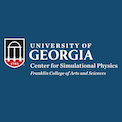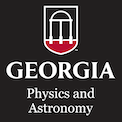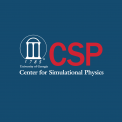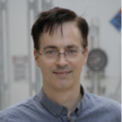Events Calendar View
-
CSP Lunch Seminar
Mar 19, 2019
Extended Ensemble Monte Carlo Simulations of Coarse-Grained Protein Models

Guest: Alfred Farris, Center for Simulational Physics, UGA
Tuesday, March 19, 2019 12:30 pm - 1:30 pm
Location: CSP Conference Room (322) -
Applied Physics Seminar
Mar 22, 2019
Models for Evaluating Next Generation Vaccines and Diagnostics for Tuberculosis
Due to the lack of an effective vaccine, sensitive and specific point-of-care diagnostics and the continuing development of drug resistance, tuberculosis is evolving to become an untreatable disease for a growing number of people. Models that can effectively mimic the various disease states will help generate accurate markers/diagnostics, and subsequently improve the vaccine and treatment options. My research program focuses on identifying and studying genetic mechanisms of Mycobacterium tuberculosis and M. bovispathogenesis, and using these factors as therapeutic, diagnostic and vaccine targets. Most recently, we have begun to employ the use of novel animal models, including the ferret transmission model.
-
CSP Lunch Seminar
Mar 26, 2019
The Evolution of Intermediate-Velocity Clouds on a Collision Course with the Galactic Disk

Guest: Matt Parker, Center for Simulational Physics, UGA
Tuesday, March 26, 2019 12:30 pm - 1:30 pm
Location: CSP Conference Room (322) -
Departmental Colloquium
Mar 28, 2019
Perovskite Chalcogenides: New Semiconductors for Visible to Infrared Optoelectronics
Perovskite Chalcogenides are a new class of semiconductors, which have tunable band gap in the visible to infrared part of the electromagnetic spectrum. Besides this band gap tunability, they offer a unique opportunity to realize large density of states semiconductors with high carrier mobility. In this talk, I will discuss some of the advances made both in my research group and in the research community on the theory, synthesis of these materials and understanding their optoelectronic properties. First, I will discuss how structure and chemical composition in Zr-containing perovskite sulfides can tune the optical properties in the visible spectrum, with an eye towards solar energy conversion. Second, I will discuss how the band gap can be further reduced to the infrared region for Ti-containing perovskite sulfides. I will also discuss about their anisotropic optical properties and large linear optical response. Finally, I will provide a general outlook for future studies on these exciting new class of materials.
References:
Nature Photonics, 12, 392-396 (2018).
Advanced Materials 29, 1604733 (2017).
Chemistry of Materials, 30 (15), 4897-4901 (2018).
Chemistry of Materials, 30 (15), 4882-4886 (2018). -
CSP Lunch Seminar
Apr 2, 2019
Finite-size Scaling for a First-order Transition where a Continuous Symmetry is Broken
-
Departmental Colloquium
Apr 4, 2019
Correlated Nanoelectronics
The study of strongly correlated electronic systems and the development of quantum transport in nanoelectronicdeviceshavefolloweddistinct,mostlynon-overlappingpaths. Electroniccorrelations of complex materials lead to emergent properties such as superconductivity, magnetism, and Mott insulator phases. Nanoelectronics generally starts with far simpler materials (e.g., carbon-based or semiconductors) and derives functionality from doping and spatial confinement to two or fewer spatial dimensions. In the last decade, these two fields have begun to overlap. The development of new growth techniques for complex oxides have enabled new families of heterostructures which can be electrostatically gated between insulating, ferromagnetic, conducting and superconducting phases. In my own research, we use a scanning probe to “write” and “erase” conducting nanostructures at the LaAlO3/SrTiO3 interface. The process is similar to that of an Etch-a-Sketch toy, but with a precision of two nanometers. A wide variety of nanoscale devices have already been demonstrated, including nanowires, nanoscale photodetectors, THz emitters and detectors, tunnel junctions, diodes, field-effect transistors, single-electron transistors, superconducting nanostructures and ballistic electron waveguides. These building blocks may form the basis for novel technologies, including a platform for complex-oxide-based quantum computation and quantum simulation.
Page 92 of 121, showing 6 records out of 723 total, starting on record 547, ending on 552





